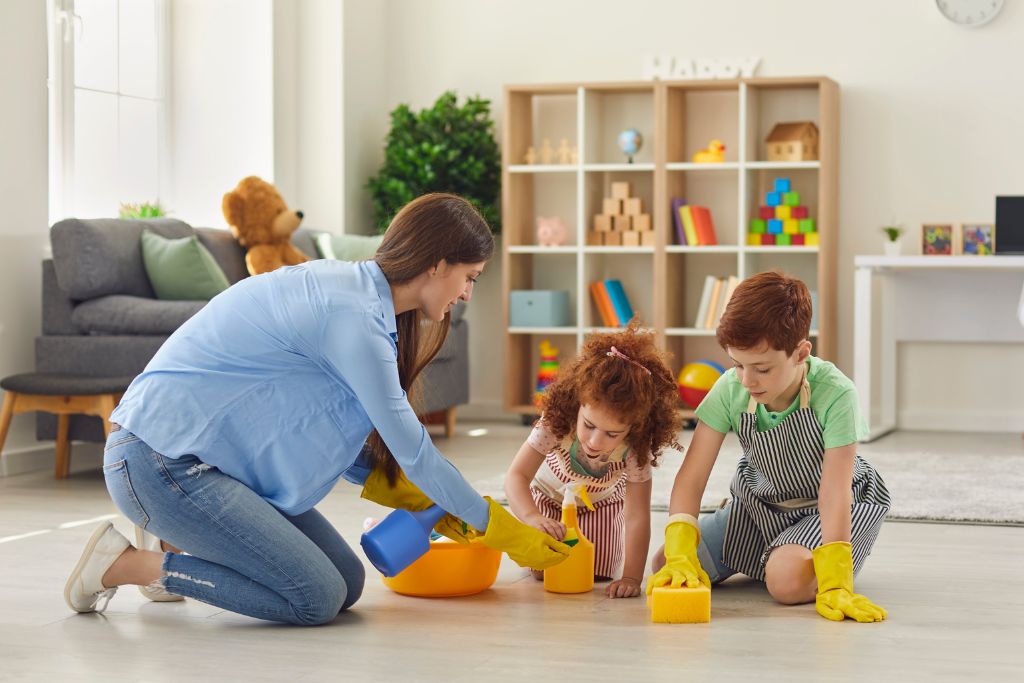According to scientific statistics, children’s academic achievement, sense of responsibility and social skills are associated with their involvement in household chores in early childhood [1]. Housework can be a great opportunity to teach children about independence, tidiness and cooperation. This is an important part of education, as young children can learn how to take care of the house and handle household products safely.
Make cleaning a game. Natural cleaning products such as vinegar, baking soda or lemon juice are perfect for this. After all, it’s all about keeping them interested, so let them squeeze lemon juice or pour soda into a cup, then dip an old toothbrush into the solution and clean the stains themselves. Of course, sometimes natural products may not be able to remove stubborn stains, and it is important to pay attention to the ingredients of aggressive cleaning products. Here are some of the ingredients that are recommended to avoid in cleaning products:
- Chlorine (sodium hypochlorite) – such products can be dangerous if they accidentally come into contact with other cleaning products, such as acids or ammonia, resulting in the release of toxic vapours that can cause respiratory damage [2].
- It is not uncommon to find ingredients such as formaldehyde, which is a known carcinogen, or phosphoric acid in aggressive cleaning products, which in high concentrations can be dangerous and cause eye/skin/respiratory irritation [2].
- Triclosan is a substance that works against fungi and bacteria and can be found in a wide range of detergents, soaps, toothpastes and surgical cleaning products. This chemical component is known for its endocrine disrupting effects and can cause allergic skin reactions [2, 3].
- Phthalates are chemical compounds that can be found in a wide range of products: scented cosmetics and perfumes, household products, children’s toys, plastic containers, car parts and much more. Phthalates in household products can be identified by chemical names such as diethyl phthalate (DEP), dimethyl phthalate (DMP), di(2-ethylhexyl) phthalate (DEHP), di-n-butyl phthalate (DnBP), dibutyl phthalate (DBP) and benzyl butyl phthalate (BBP). Pay attention to product labels, which often emphasise that the product is phthalate-free [3].
Household cleaners containing aggressive ingredients can cause allergic reactions and skin irritations in children [4]. For these reasons, it is very important to ventilate the room after cleaning, as toxic vapours can cause respiratory or eye irritation if they become airborne. It is important to protect your little ones and to allow their bodies to develop their own bacterial background, so we do not encourage you to strive for an ideal home cleanliness like a hospital operating theatre. On the contrary, some researchers believe that too clean a home can increase a child’s long-term allergy risk. So, for these everyday chores, we have prepared for you some instructions on how to make highly effective cleaning products that can be made at home:
For the bathroom:
- Sprinkle baking soda and vinegar into the toilet bowl and wipe with a toilet brush.
- Bathroom and tile cleaner. Sprinkle baking soda on surfaces like scouring powder, then pour vinegar on a sponge, scrub the surfaces, and then rinse with water or any other method you prefer.
- Lime and mineral deposit remover. Hard limescale deposits around the faucets can be softened, making them easier to remove. Cover the sediment with paper towels moistened with vinegar. Leave paper towels on for about 1 hour before cleaning (especially suitable for chrome surfaces, leaving the chrome clean and shiny).
Furniture cleaning:
- Mix 3 parts olive oil and 1 part vinegar in a spray bottle and clean the furniture with a clean, soft cloth.
Floor cleaning:
- Wooden floors are becoming more popular these days and manufacturers often sell ‘special’ cleaners, but vinegar and water have a similar effect.When cleaning wooden floors, use 1 cup of vinegar per bucket of hot water.Vinegar helps to degrease the floor and revitalise it, and you can also add a little of the natural cleaner to a bucket of water if needed.
List of references:
- Lemire et al. Domestic exposure to irritant cleaning agents and asthma in women. Environment International. Vol. 144, 2020https://doi.org/10.1016/j.envint.2020.106017
- Joseph S. Bukalasa, Bert Brunekreef, Gerard H. Koppelman, Judith M. Vonk, Ulrike Gehring, Use of cleaning agents at home and respiratory and allergic symptoms in adolescents: The PIAMA birth cohort study, Environment International, 128, 2019, Pages 63-69, ISSN 0160-4120, https://doi.org/10.1016/j.envint.2019.03.049.
- Gharpure, R., Hunter, C.M., Schnall, A.H., Barrett, C.E., Kirby, A.E., Kunz, J., Berling, K., Mercante, J.W., Murphy, J.L. and Garcia-Williams, A.G. (2020), Knowledge and practices regarding safe household cleaning and disinfection for COVID-19 prevention – United States, May 2020. Am. J. Transplant., 20: 2946-2950. https://doi.org/10.1111/ajt.16300
- Jean-Yves Maillard, Sally F. Bloomfield, Patrice Courvalin, Sabiha Y. Essack, Sumanth Gandra, Charles P. Gerba, Joseph R. Rubino, Elizabeth A. Scott, Reducing antibiotic prescribing and addressing the global problem of antibiotic resistance by targeted hygiene in the home and everyday life settings: a position paper, American Journal of Infection Control,Vol. 48, Issue 9, 2020, p.p.: 1090-1099, ISSN 0196 6553,https://doi.org/10.1016/j.ajic.2020.04.011.


